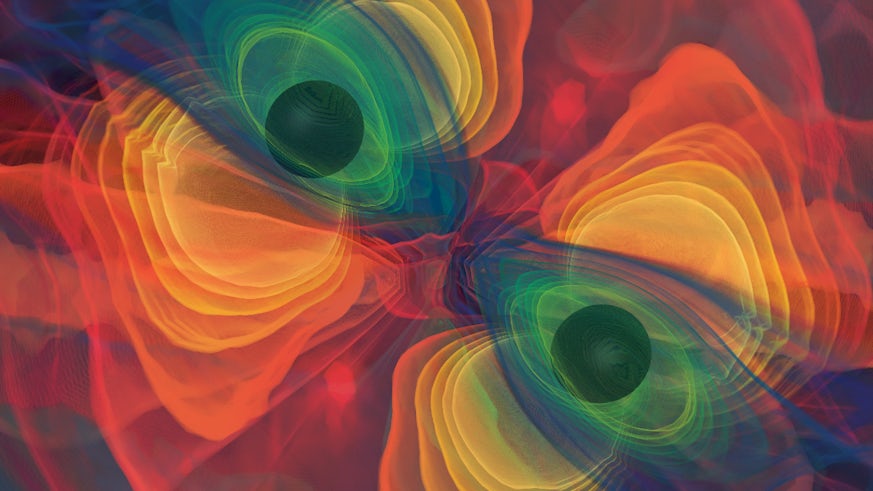Astronomers detect new gravitational wave
15 June 2016

LIGO scientists detect “fantastically weak” gravitational wave signal from the merging of two black holes
Experts at Cardiff University are hailing the “true beginning” of gravitational wave astronomy after their highly advanced models were used to identify another gravitational wave from the merger of two black holes.
The detection, announced was made by the LIGO (Laser Interferometer Gravitational-Wave Observatory) Scientific Collaboration (LSC) on 26 December 2015, just three months after a gravitational wave was detected for the very first time.
Known as the ‘Boxing Day event’, the newly detected gravitational wave originated from the merging of two black holes over a billion years ago, but the signal that reached Earth was incredibly weak. This meant large-scale computer simulations that model how black holes collide, combined with sophisticated analysis algorithms, both jointly developed at Cardiff University, were needed to tease the signal from the data.
Dr Stephen Fairhurst, who jointly lead the writing of the papers reporting these results, said “This event heralds the true beginning of gravitational wave astronomy and the opening of a new window on the universe. Gravitational wave observations will allow us to understand how black holes form from the death of massive stars, and test whether they are really as predicted by Einstein’s theory.”
Professor Mark Hannam, who leads Cardiff’s modelling effort, said: “The different masses and observable spins that we witnessed in the Boxing Day event show that we’re starting to collect vital information about the population of black holes that exist out there in the Universe."
An analysis of the data showed that the black holes were much lighter than the black holes previously observed by LIGO. The newly detected black holes were 2-5 million times more massive than the Earth but less than 100 km wide, and collided in a distant galaxy to form a single larger black hole.
One noticeable difference from the previously detected event was that at least one of the black holes was spinning, according to the new data. Astrophysicists have long suspected that black holes should spin, but this phenomenon has been very difficult to measure with telescopes.
Dr Patrick Sutton, head of the gravitational physics group, said: “In the coming years, gravitational waves will allow us to peer into the cores of exploding stars, probe the structure of neutron stars – the densest known objects in the universe – and potentially see completely new and unexpected phenomena that will challenge our current understanding of the Universe.”
Cardiff’s Professor B S Sathyaprakash explained: “Compared to the first event, the gravitational wave signal we detected was fantastically weak, causing a displacement in LIGO’s detectors of less than one-thousandth the size of an atomic nucleus. Using our models and algorithms we were able to tease this signal from the data to reveal the tell-tale signs of a black hole merger and infer the properties of the two individual black holes.
"With the initial detection we could not have made any concrete statement about cosmological applications of binary balck hole observations. However, with the second event we are now confident that these are going to be prime sources in the future to aid us in understanding the origin, evolution and ultimate fate of the entire Universe.”
First predicted by Einstein in 1916, gravitational waves are tiny ripples in space-time that are emitted as a result of violent cosmic events, such as exploding stars and merging black holes. Gravitational waves carry information about their dramatic origins and about the nature of gravity that cannot otherwise be obtained.
Research undertaken at Cardiff University has laid the foundations for how we go about detecting gravitational waves with the development of novel algorithms and software that have now become standard search tools for detecting the elusive signals.
The Gravitational Physics Group also includes world-leading experts in the collision of black holes, who have produced large-scale computer simulations to imitate these violent cosmic events and predict how gravitational waves are emitted as a consequence. These calculations were instrumental in decoding the observed gravitational-wave signal to measure the properties of the two black holes.
LIGO research is carried out by the LIGO Scientific Collaboration (LSC), a group of around 950 scientists from universities in over 15 countries. The LSC detector network includes the LIGO interferometers in Livingston, Louisiana, and Hanford, Washington. The discovery was made possible thanks to a major upgrade to the detectors, labelled Advanced LIGO (aLIGO), that increased the ultimate sensitivity of the instruments by a factor of 10, enabling a 1,000-fold increase in the volume of the universe within reach of LIGO.
